Sweet (bell) peppers are affected by many different diseases. Their manifestation depends on growing conditions and soil.
Like any crop, bell peppers must be properly cared for, then you won’t have to fight diseases.
| Contents: Diseases of bell pepper
|
Specifics of the spread of pepper diseases
In the middle zone, the most common diseases of sweet pepper are: gray and white rot, blossom end rot. In the southern regions, plants are affected by root rot and stolbur.
In the Far East and Eastern Siberia, the crop is more often affected by black bacterial spot, and in Western Siberia - by white and brown spot.
Late blight and streak are widespread.
The fight against sweet pepper diseases should begin at the first signs of disease. Only timely measures can stop the development of the disease.
Late blight
In the north and central region, sweet peppers are quite resistant to this disease and, when grown in a greenhouse in a monoculture, are practically not affected by it. But if it grows together with tomatoes or there are potato plantings next to the greenhouse, then the bell pepper may also get sick, but Late blight does not harm it as much as it does tomatoes.
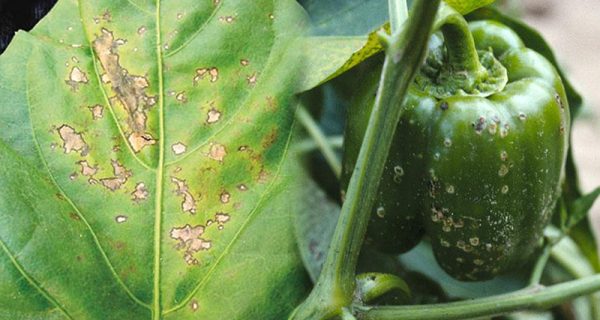
The photo shows late blight on pepper in the initial stage
In the southern regions, the disease can manifest itself independently, without its symptoms appearing in other crops. It affects plants both in open and protected ground.
Pathogen - a pathogenic fungus that lives in soil and plant debris. The source of infection can be seeds, as well as other crops infected with late blight.
Conditions of defeat
Mass infection occurs in the second half of summer, although in the southern regions late blight can appear even on seedlings.In the northern regions, its appearance is facilitated by cool weather combined with high air humidity, in the southern regions by heat and heavy rains.
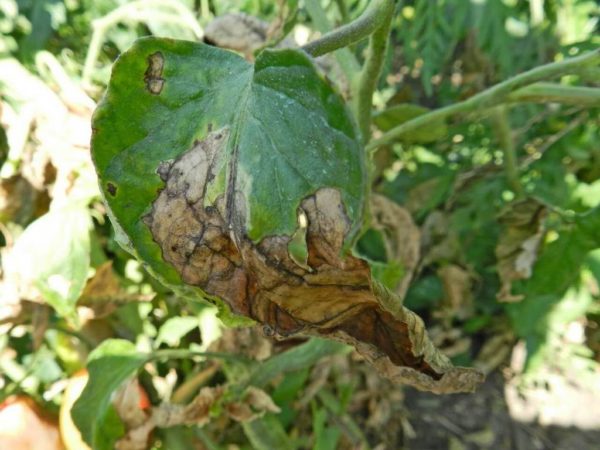
Photo of pepper leaves affected by late blight
Signs of illness
Stems, leaves and fruits are affected. Brown stripes with jagged edges appear on the stems, which ring it.
Brown-brown spots without clear boundaries appear on the leaves, which quickly merge. The leaf turns black.
Small brown spots appear on the fruits, which then quickly grow, the tissue wrinkles and becomes soft and thin to the touch.
Depending on the weather, the affected areas either rot or dry out. The affected bush itself dies.
Measures to combat late blight
Treatments should be started not when the first signs of the disease appear, but when the risk of its occurrence increases (heavy rains or cool weather).
- Consento or Previkur. Plants are sprayed with Consento solution 4 times with an interval of 10 days. Previkur solution is used to water plants at the roots every 10 days when there is a high risk of disease.
- Copper preparations (except Bordeaux mixture) perfectly protect peppers from late blight. Carry out 2-3 treatments per summer. Copper-containing preparations can be alternated with fungicides of other groups.
- Use of drugs Metaxil, Bravo, Quadris.
- Treatment with biological products: Fitosporin, Baktofit, Pseudobacterin, Trichodermin. Trichodermin and Pseudobacterin give especially good results. In order for the biological objects to remain on the plant and begin to work, adhesives (gelatin, starch glue, fat milk) are added to the working solution. You cannot add laundry soap, since it, having an alkaline reaction, destroys beneficial microflora.
Late blight
Treatments are carried out throughout the entire growing season, alternating preparations of different chemical groups, except for biological products. Biological products are used independently; they cannot be combined with chemical pesticides, since the latter destroy all microflora, including beneficial ones.
Disease prevention
- Prevention begins with seed treatment. They are kept for 20 minutes in a warm pink solution of potassium permanganate.
- Regular ventilation of greenhouses. Even in cold weather (20°C and below), the windows are opened to allow air circulation.
- In peppers, like tomatoes, the lower leaves are removed so that they do not come into contact with the ground and there is no infection through them.
- At the same time as peppers, tomatoes, eggplants and potatoes are processed.
Streak (streakness)
The causative agent is a virus. It affects fruits, petioles and stems mainly in the upper part of the bush.
Conditions of defeat. The virus manifests itself regardless of weather conditions. More often the disease occurs in the second half of summer. It is spread by insects. Greenhouse peppers suffer more from streaking.
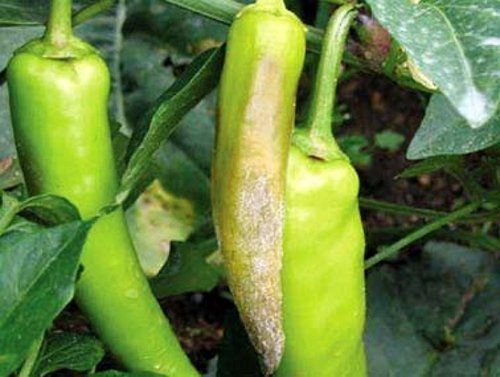
Streak
Signs of defeat
The first signs appear in July. Light gray or brownish streaks appear on the fruits, unevenly distributed throughout the peppercorn.
Strokes appear on the stems and petioles a little later. As a result, they become bent, cease to perform their functions and break.
The tissue at the site of the lesion becomes corky, and the strokes themselves acquire a light brown color. The fruits become unsuitable for food.
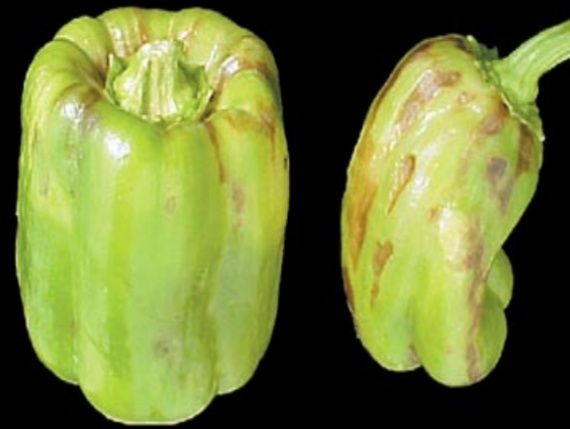
Streak
Spreading. The streak spreads quickly, and by August all the plants in the greenhouse may become diseased.
How to fight the disease
Since the virus lives and multiplies inside cells, it is necessary to use only systemic drugs.The only drug that acts on the virus is Farmayod. But fruits cannot be treated with it, since the iodine contained in the preparation causes severe burns to the skin of the fruit and leads to its rotting.
Therefore, processing is carried out only after removing all the fruits of technical ripeness. 5 ml of Farmayod is dissolved in 10 liters of water and the plants are thoroughly sprayed. The treatment is repeated after 10 days, after removing healthy fruits.
Since Farmayod contains a high concentration of iodine, burns and death of leaves and plants are possible if the working solution is not prepared correctly.
Folk remedies
In the early stages of the disease, treatment with a pink solution of potassium permanganate is very effective. Treatment is carried out 3 times with an interval of 7 days. If affected petioles and peppercorns continue to appear, then proceed to treatment with Farmayod.
Stolbur
This disease of sweet pepper is typical for the southern zones of the country; in Siberia and the north it practically does not appear.
The causative agent is mycoplasma and is transmitted by cicadas. Most often, plants in open ground get sick. In addition to peppers, it affects tomatoes, eggplants, potatoes and many weeds.
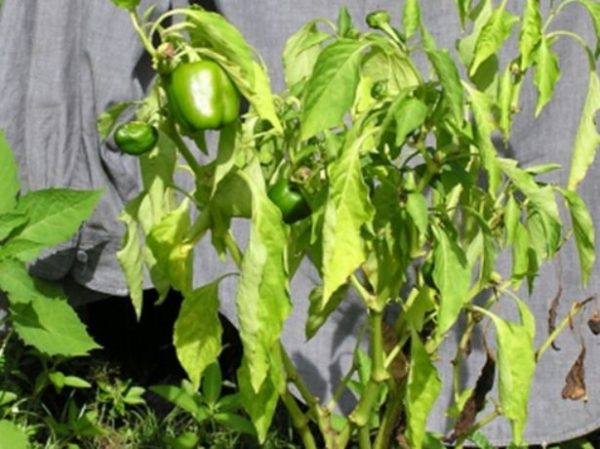
Stolbur
Conditions for the development of the disease
Mycoplasma overwinters on perennial weeds (bindweed, thistle, thistle, etc.). Spread by cicadas. Its appearance directly depends on the weather. In early and dry springs, cicadas quickly move to cultivated plants; in late springs, they live on weeds for a long time.
How to recognize the disease
Affects stems. leaves, flowers and fruits. Stolbur damage is similar to signs of viral diseases, so it is often classified as a viral disease.
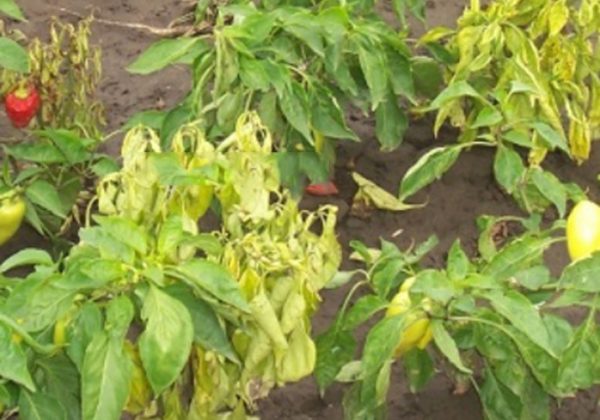
The photo shows pepper bushes infected with stolbur.
- The disease begins at the top of the bush. Young leaves are crushed, acquire a pale green color, fold in a boat along the central vein and rise up. With further development of the disease, the leaves become mosaic and wither.
- The stems sometimes thicken (not often), rise up and become bare. Internodes are shortened.
- The flowers become sterile and are not pollinated, and the ovaries fall off.
- The fruits become crushed and become ugly and woody. Very often they bend and turn red very quickly. The peppercorns taste tasteless, woody and hard.
- The disease spreads from the top to the entire plant. The leaves dry out but do not fall off. If you visit the dacha only on weekends, you might think that the bush has dried out from the heat or lack of watering.
Stolbur is carried only by insects; it is not spread by wind, water, or when a diseased plant comes into contact with a healthy one. Therefore, the disease is focal in nature. Only those plants on which the cicadas have settled die.
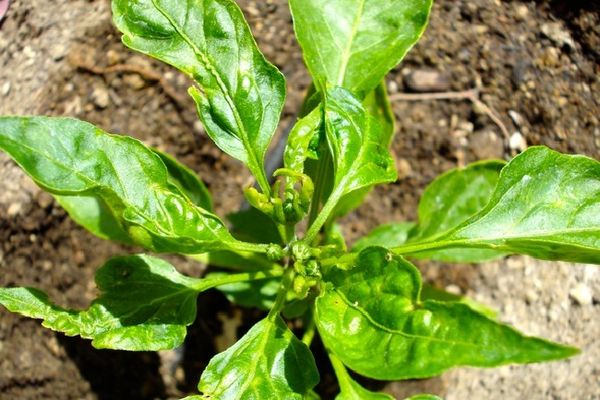
Photo of leaves affected by stolbur
The affected plant dies. Diseased bushes are removed and burned.
How can you fight the disease?
There are no effective measures to combat this pepper disease. All control measures are aimed at combating cicadas.
- When insects appear or for preventive purposes (if cicadas have begun), peppers (tomatoes, eggplants, potatoes) are treated with insecticides: Karbofos, Decis, Aktara, Iskra.
- Treatment is carried out in the evening, since cicadas are active at night.
- Spray on the underside of the leaf, since insects live there.
- Spraying is carried out throughout the season at intervals of 10 days, since cicadas reproduce very quickly. Treatments are stopped 30 days before harvest.
The photo shows a bell pepper plantation affected by stolbur.
Since cicadas are very light and are carried by the wind over long distances, to prevent them from settling on peppers, plantings are covered with a fine mesh or material that allows air and light to pass through.
Disease prevention
Stolbur persists on weeds. Therefore, it is necessary to keep the area free of weeds.
Since the main sources of infection are difficult-to-eradicate weeds, such as thistle, field bindweed and thistle, herbicides are used against them. Mechanical removing these weeds provokes their increased regrowth. They use the drugs Tornado, Roundup, Smersh, Hurricane.
Weeds are removed not only in plantings of peppers (tomatoes, eggplants, potatoes), but also in row spacing and along the perimeter of the site.
Root rot
Root rot is very common in the southern regions and almost never in the middle zone and to the north.
A group of diseases caused by either pathogenic fungi or bacteria.
Favorable conditions for the development of the disease
They appear when plantings are thickened and the soil is poorly ventilated. Root rot can occur when the concentration of fertilizer solution applied under the root is too high. As a result, the roots are burned, necrosis and cracks form on them, through which pathogens penetrate inside.
Other reasons are severe waterlogging and frequent rains, when the soil does not have time to dry out; mechanical damage during loosening.
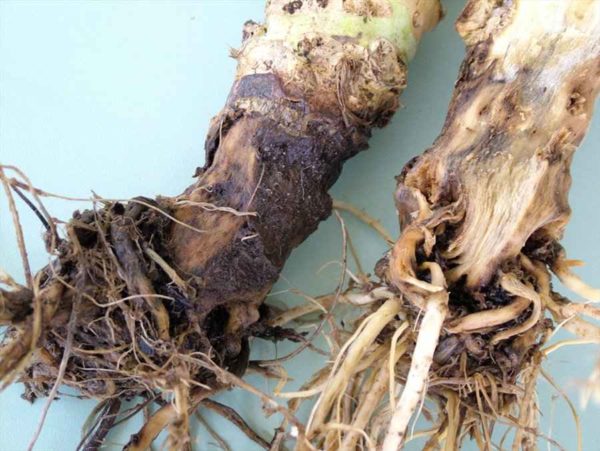
Root rot
Rot affects peppers throughout the growing season.
How does the disease manifest itself on peppers?
- The leaves of the bushes, despite the moist soil, begin to wither and dry out. Depending on the degree of waterlogging, they either dry out or rot.
- The root collar becomes slimy and rots, and sometimes spots of pinkish or white plaque appear on it.
- Diseased peppers are easily removed from the ground; there is practically no soil on the roots. The roots themselves are brown, sometimes slippery to the touch (not always), and break easily (healthy roots are white and elastic).
Control measures
Since the main reason is waterlogging of the soil, drainage is provided in the beds. When the first signs of disease appear, diseased pepper bushes are removed, the rest are shed with solutions of Pseudobacterin or Fitosporin.
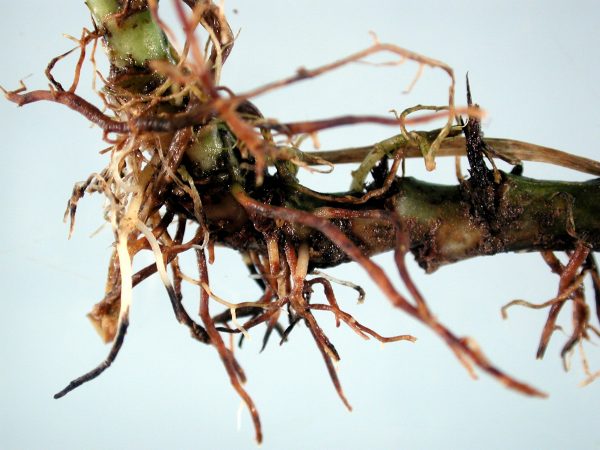
The photo shows root rot
In the south, where summers are hot, when the disease appears, you can immediately use the drug Tiovit Jet. It contains colloidal sulfur and has an excellent effect on a number of pathogenic fungi, including Fusarium, which often causes root rot.
The drug is effective at temperatures above 20°C; at lower temperatures it does not work, so it is used when the temperature at night is not lower than 20°C.
Prepare a working solution and water at the root. As a rule, one treatment is made at the onset of the disease, but if there are heavy rains, then for preventive purposes, after 10 days, the pepper is watered again.
Currently withdrawn several varieties resistant to root rot:
- Hercules - practically not affected by fusarium;
- Swallow - resistant to bacterial rot of roots and aerial parts;
- Gift of Moldova is a very old Soviet variety. It is practically not affected by root rot.
Root rot persists in the soil for an extremely long time, therefore, if it appears, then after harvesting or before planting seedlings, the soil is generously spilled with a dark solution of potassium permanganate.
Apical rot
A disease caused by a lack of calcium in the soil.It is especially common on sweet peppers in the northern regions, where the soils are poor in this element. On black soils blossom end rot occurs much less frequently.
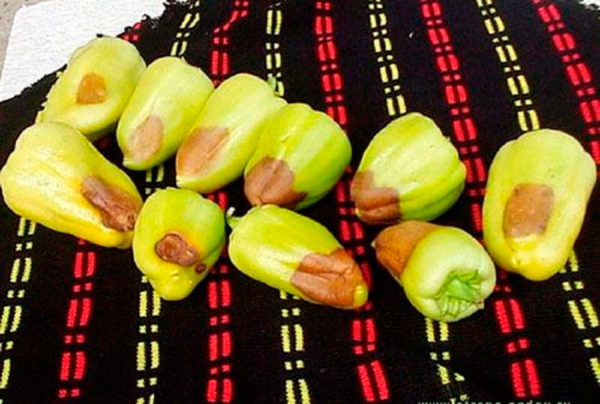
The photo shows peppers affected by blossom end rot.
What causes blossom end rot?
The disease on peppers appears at the beginning of fruiting.
- Lack of calcium in the soil.
- Water containing a lot of iron. Iron reduces calcium absorption.
- Rare watering. Bell pepper does not tolerate drying out of the soil and when humidity decreases, all elements, and calcium in the first place, cease to be absorbed.
Large-fruited, thick-walled, late-ripening varieties are more affected because they require much more calcium than normal.
Signs of defeat
Appears only on green fruits, mainly in greenhouses. When grown in garden beds in greenhouses, the disease appears less frequently and only on some plants.
At the top of the green fruit (where the flower was) a light brown spot appears, which gradually increases in size and acquires a richer brown color. The stain gradually grows, the tissue wrinkles, presses in and dries out.
However, in most cases, the spot does not appear at the top but on the side closer to the tip of the fruit. It also gradually grows along the side surface and dries out.
Affected fruits quickly turn red, but become tough and tasteless.
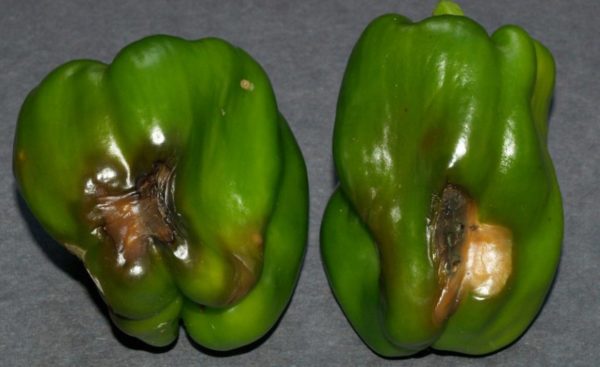
Apical rot
How to prevent this sweet pepper disease
Measures to combat the disease consist of increasing the dose of calcium in fertilizing. Use calcium nitrate for spraying or applying under the root. Sweet peppers in northern regions are more sensitive to calcium deficiency than tomatoes grown with them in the same greenhouse.Therefore, fertilizing is done every 15 days until the end of fruiting.
For large-fruited, thick-walled peppers, the calcium norm during the fruiting period increases by 1.5 times.
Now there are calcium preparations in the form of a suspension that are used for foliar feeding: Vuksal Calcium, Kalbit S. They contain from 15% to 24% calcium and completely eliminate blossom end rot.
Folk remedies
Ash is very effective in preventing and treating disease. Those who feed peppers with it or add it to the holes when planting sweet peppers do not suffer from blossom end rot.
For 10 liters of water take 10 glasses of ash. The solution is either boiled for 15 minutes or left for 24 hours, stirring regularly. It is advisable to simultaneously water the peppers at the root and spray them.
There are varieties that are practically not affected by the disease: Spring, Mazurka.
Gray rot
It develops only in greenhouses. The disease is very persistent and persists for a long time in the soil and on plant debris. The causative agent is a pathogenic fungus, which is quickly transferred from plant to plant with water and air currents.
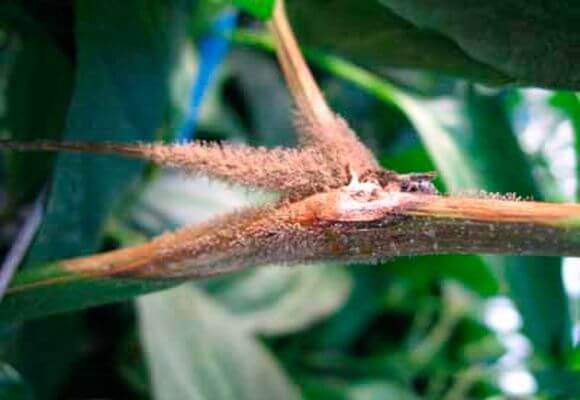
Gray rot
Favorable conditions for the development of the disease
Favorable conditions for development are high humidity in greenhouses, poor ventilation and sudden changes in day and night temperatures. But if the pathogen appears once on plants (be it greenhouse cucumbers, tomatoes, peppers or eggplants), then in subsequent years the disease will manifest itself even under unfavorable conditions for it. In this case, it develops slowly, but still continuously.
Signs of gray mold disease in pepper
Appears in the second half of summer. Affects stems, flowers and fruits.If the stems are damaged, the plant dies; if the fruits become diseased, only the peppercorns are damaged, but from them the rot can spread to the stem.
The most dangerous lesions are the stem. Brown-gray weeping and slimy spots appear on it, which quickly spread up and down the stem. After a few days, the spots turn grayish-white and then turn dark gray. The affected stem dies, the leaves on it dry out, and the stem itself, depending on the humidity, either dries out or becomes slimy.
On flowers, rot begins at the receptacle (where the flower is attached to the stem). The receptacle completely softens and rots. The affected flower or ovary falls off.
As a rule, the disease affects green peppers or commercially ripe fruits. Olive-green spots appear on the fruits. Typically, the spots appear closer to the stalk, although they can be localized on any part of the peppercorn. The fabric feels watery, thin, and soft to the touch. Gradually, the spot spreads throughout the fruit, and gray spots of fungal sporulation appear on it.
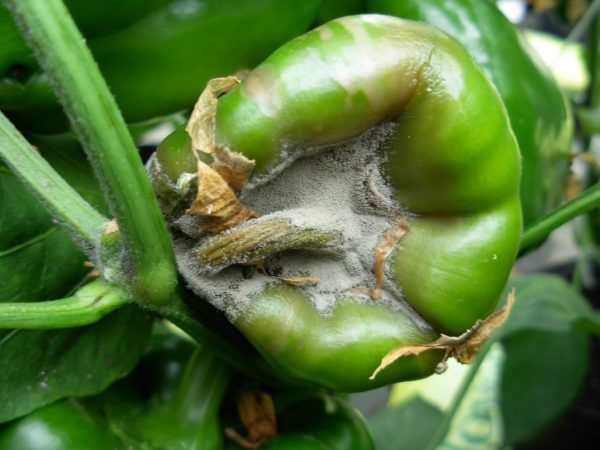
Gray rot
Ways to combat gray mold on pepper
It is difficult to fight the disease; gray rot is very persistent, so when it appears, treatments are carried out throughout the season, even if there are no signs. Once you let your guard down, the disease will appear immediately.
- Treatment with Bayleton, Topsin M or Euparen.
- Spraying and watering at the root with biological products Glycladin, Gamair, Trichodermin.
- Stripping diseased stems from diseased tissue and dusting them with chalk.
- Tomato Rescuer 3-1. This product consists of 3 ampoules: insectoacoricide, fungicide and stimulant. In addition to tomatoes, it can be used on all nightshade crops.The fungicidal component protects pepper well not only from rot, but also from late blight and various spots.
The treatment is carried out in the first half of the day and the greenhouse is thoroughly ventilated so that the bushes are completely dry by the evening.
Folk remedies
If last year there was gray rot in the greenhouse, then after planting the seedlings they immediately begin treatment with biological products Trichodermin, Gamair, Fitosporin. Spraying is carried out once every 7-10 days throughout the entire growing season, even if there are no signs of disease. Biological products can be alternated with each other.
At the initial stage, peppers are sprayed with a strong solution of potassium permanganate.
Prevention consists of thoroughly ventilating greenhouses in any weather. Humidity should not exceed 80%.
Mandatory removal of all affected fruits and diseased plants.
White rot (sclerotinia)
On peppers it is less common than other types of rot. It affects the stem and sometimes the fruit. The causative agent is the pathogenic fungus sclerotinia.
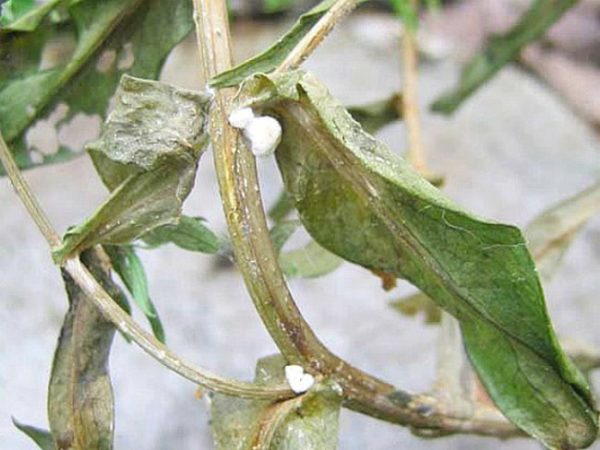
The photo shows white rot
Favorable conditions for the appearance of white rot
Sudden changes in air temperature and high humidity. Distributed mainly in greenhouses. The most dangerous periods are immediately after planting, if the weather is cold, and when the lower fruits ripen.
Signs of disease on pepper
It can develop on any part of the stem, although it is more often localized in the root zone. A white fluffy coating appears on the affected area, and black spots are visible on the cut, which later soften and become slimy. The tissue becomes watery and wrinkles. The bush dies.
Fruits are only affected when they come into contact with the ground. Diseased peppercorns become soft, thin, watery, and subsequently a white coating appears on them.The diseased fruit rots and falls off.
White rot spreads in patches and does not affect all peppers at once.
Control measures
Sweet peppers are not as severely affected by white rot as tomatoes. Therefore, it is enough to spray it with biological preparations Trichodermin or Fitosporin.
If the lesion is more extensive, then use Planriz, Gamair. The white coating is cleaned off, and the stem is coated with a paste containing chalk or charcoal.
If the fruits are damaged, the diseased peppercorns are removed, the rest are sprayed with copper preparations: OxyHOM, Ordan.
Disease prevention
In cold weather, peppers are additionally covered with straw or covering material. Humidity is maintained at 80%. All leaves are cut up to the fork, and the bush itself is thinned, removing excess branches.
Diseased fruits are removed and burned. When the peppercorns come into contact with the ground, hay, straw or just cardboard is placed under them.
Folk remedies. Spray with a strong solution of potassium permanganate or iodine 10 ml/10 l of water.
Black bacterial spot
Often found in Siberia, sometimes in the south. It does not appear in the middle zone.
Pathogen - a pathogenic bacterium that survives on plant debris and seeds. The pathogen is extremely resistant to adverse factors: it can withstand drying and prolonged low temperatures. Kills within 5 minutes when exposed to temperatures of 56°C and above.
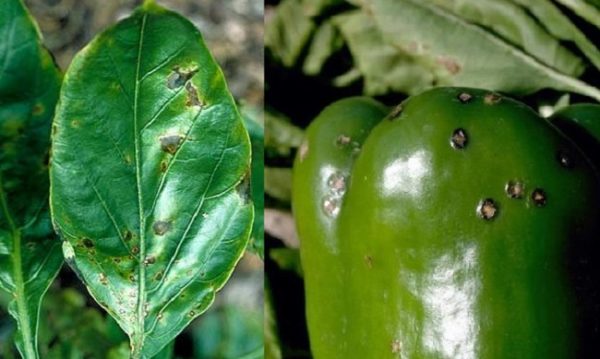
The photo shows black bacterial spot on leaves and fruits
Favorable conditions
Rainy and hot summer with a temperature of 25-35°C, high humidity in the greenhouse. It is found both in open and protected ground.
Signs of defeat
It affects all above-ground parts of the plant from seedlings to the end of the growing season.
- Light yellow angular spots appear on the leaves along the veins, framed at the edges by a dark border. Severely affected leaves fall off. Gradually the spots turn black and the border becomes yellowish.
- The spots on the stems are elongated, black, and gradually merge with each other.
- Black convex dots appear on the peppercorns, surrounded by a watery border. Gradually, the spots increase in size and turn into ulcers, and the border becomes greenish in color. The pepper begins to rot from the inside.
Young stems, leaves and fruits are first affected, then the disease spreads to older tissues. The pathogen affects fruits at technical ripeness. Young peppers die.
How to deal with this disease on peppers
At the initial stage, biological products that destroy harmful bacteria are very effective: Planriz, Gamair, Baktofit, Fitosporin. If used in time and correctly, they save young peppers from death.
At later stages, they are treated with copper preparations: HOM, OxyHOM, Bordeaux mixture.
The broad-spectrum drug Kartotsid is used. It is effective not only against spotting on peppers, but also against many other diseases (gray rot, anthracnose, downy mildew, rust, scab). Spraying is carried out from the moment of planting the seedlings every 10 days.
Using the complex drug “Tomato Rescuer”.
Prevention
- In high-risk areas, before sowing, seeds are kept in a strong solution of potassium permanganate at a temperature of 56-58 ° C for 10 minutes and then rinsed.
- Greenhouses maintain optimal temperature and humidity.
- Destruction of all plant debris.
- Soil disinfection.It is spilled with either a solution of potassium permanganate (a heaping teaspoon per 10 liters of water) or a solution of copper sulfate (1 tbsp/10 liters of water).
Alternaria blight (brown spot, macrosporiosis)
Found in Siberia. Bell pepper affects both in the greenhouse and outdoors.
Pathogen - a pathogenic fungus that survives on plant debris and seeds.
Conditions for the appearance of the disease. Hot summer (above 25°C) with short rains and heavy dew.

Pictured is Alternaria pepper blight
Signs of defeat
Leaves and fruits become diseased. The disease begins on old leaves. Small angular brown spots appear along the veins, which gradually grow and merge with each other, covering the entire affected leaf. The damage spreads from the leaves to the fruits.
On the peppercorns at the base, where the stalk is attached, a watery green spot appears, which subsequently grows, darkens and is pressed inward. Sometimes a stain may appear not at the stalk, but in the center of the peppercorn. The spot becomes brown, lighter in the center than at the edges. In advanced cases, areas with a black mold-like coating appear in the center of the spot - fungal sporulation. The fruit dries out.
Control measures
Alternaria blight on sweet peppers is not as harmful as other types of blight. It develops slowly, and when hot and dry weather sets in, its development stops.
When the disease appears, spraying with copper preparations is carried out: Ordan, Abiga-Peak, Bordeaux mixture, HOM. Treatments are carried out depending on the weather. In rainy weather, apply 2 times with an interval of 10-14 days. When warm weather sets in and there is no dew, limit yourself to one spraying.
Treatment with Kartotsid, Ridomil Gold, Previkur, Kurzat.
Prevention
- Seeds must be treated before sowing.
- The greenhouse is thoroughly ventilated so that there is no dripping moisture on the peppers; the bushes should not be watered by sprinkling.
Folk remedies. For preventive purposes, spray the bushes with a pink solution of potassium permanganate or iodine (10 ml per bucket of water).
Continuation of the topic:
- How to effectively deal with tomato diseases
- What diseases do cucumbers suffer from and how to treat them
- Why do pepper leaves curl?
- Why do bell pepper leaves turn yellow?
- Technology for growing peppers in open ground
- How to grow bell peppers in greenhouses
- How to properly water and fertilize peppers
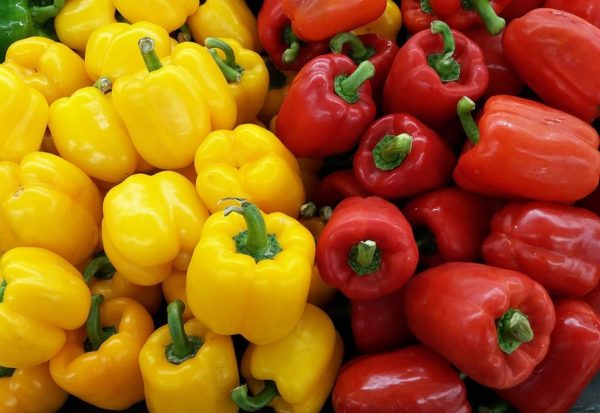
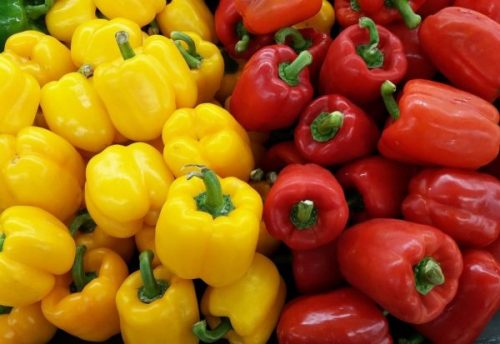
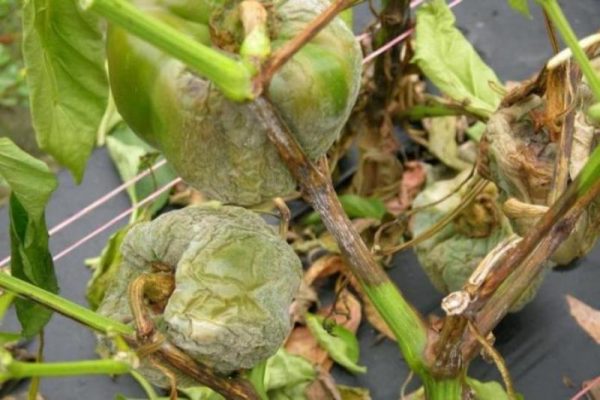
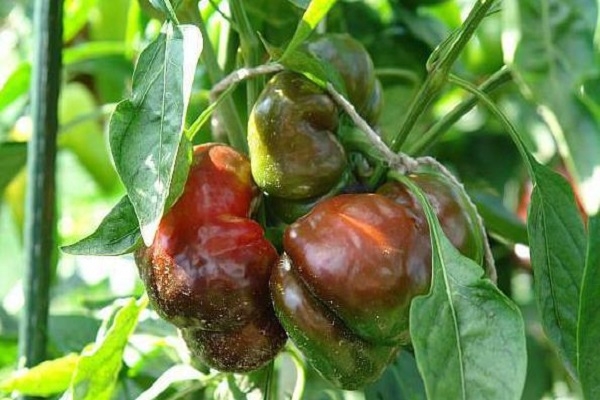
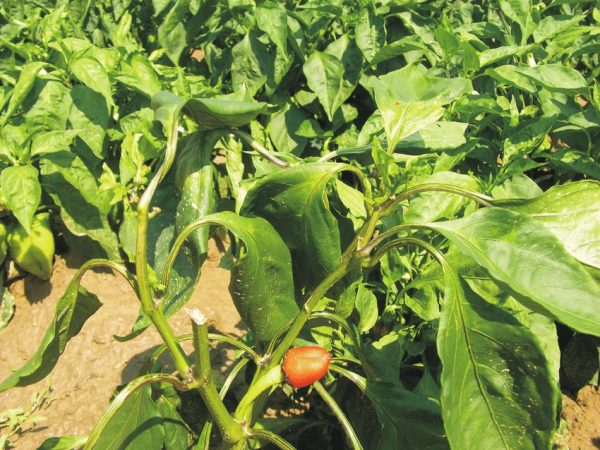
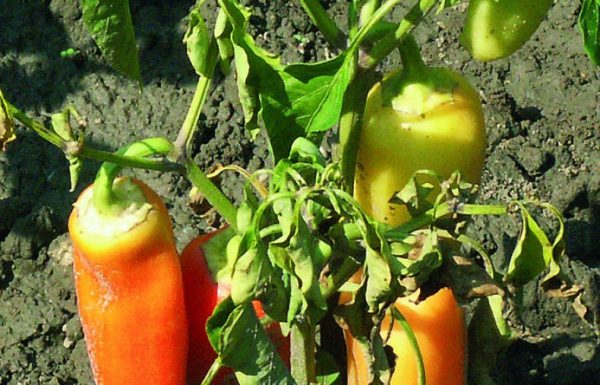
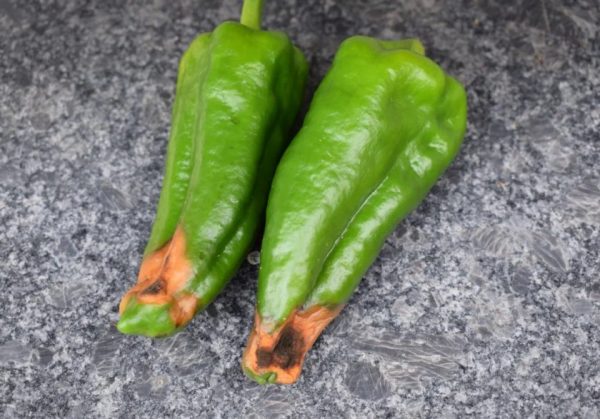
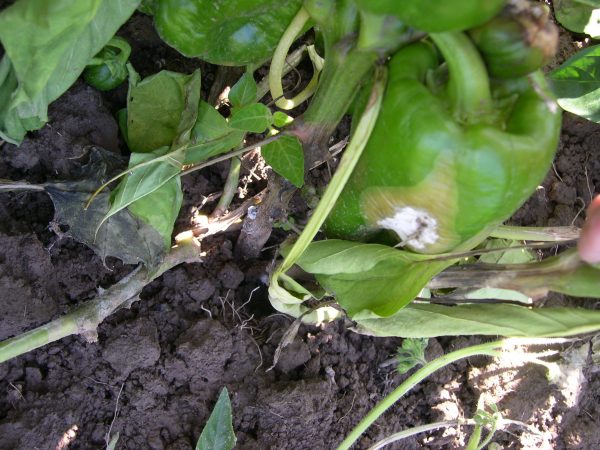

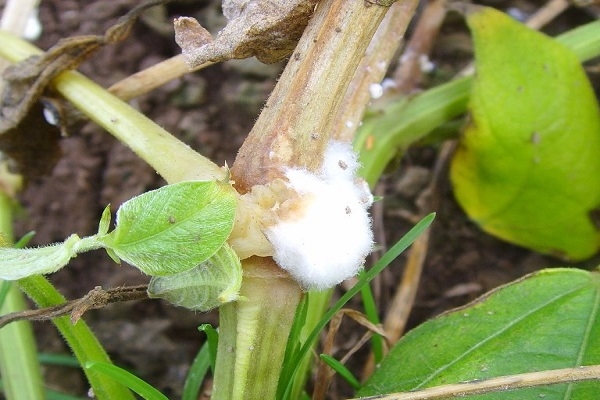
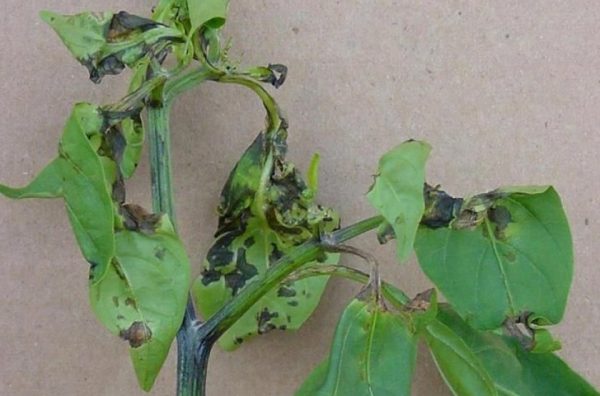
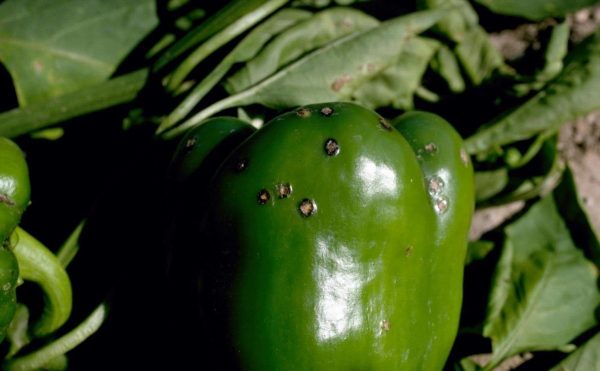
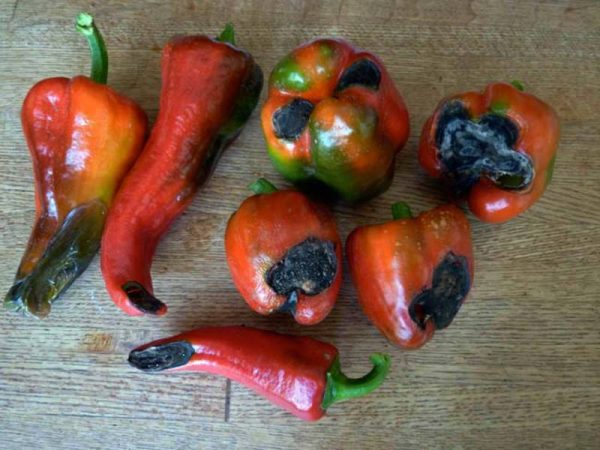

 (5 ratings, average: 4,60 out of 5)
(5 ratings, average: 4,60 out of 5) CUCUMBERS NEVER GET SICK, I'VE BEEN USING ONLY THIS FOR 40 YEARS! I SHARE A SECRET WITH YOU, CUCUMBERS ARE LIKE THE PICTURE!
CUCUMBERS NEVER GET SICK, I'VE BEEN USING ONLY THIS FOR 40 YEARS! I SHARE A SECRET WITH YOU, CUCUMBERS ARE LIKE THE PICTURE! You can dig a bucket of potatoes from each bush. Do you think these are fairy tales? Watch the video
You can dig a bucket of potatoes from each bush. Do you think these are fairy tales? Watch the video
 How our fellow gardeners work in Korea. There is a lot to learn and just fun to watch.
How our fellow gardeners work in Korea. There is a lot to learn and just fun to watch. Eye trainer. The author claims that with daily viewing, vision is restored. They don't charge money for views.
Eye trainer. The author claims that with daily viewing, vision is restored. They don't charge money for views. A 3-ingredient cake recipe in 30 minutes is better than Napoleon. Simple and very tasty.
A 3-ingredient cake recipe in 30 minutes is better than Napoleon. Simple and very tasty. Therapeutic exercises for cervical osteochondrosis. A complete set of exercises.
Therapeutic exercises for cervical osteochondrosis. A complete set of exercises. Which indoor plants match your zodiac sign?
Which indoor plants match your zodiac sign? What about them? Excursion to German dachas.
What about them? Excursion to German dachas.